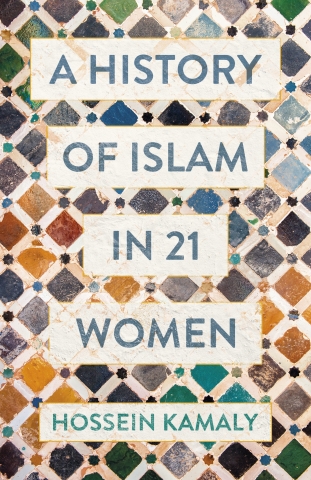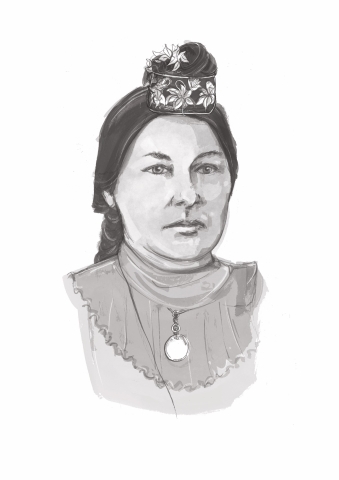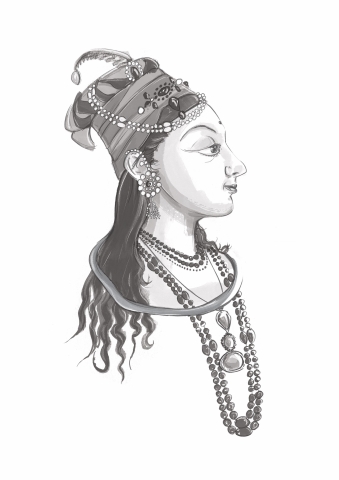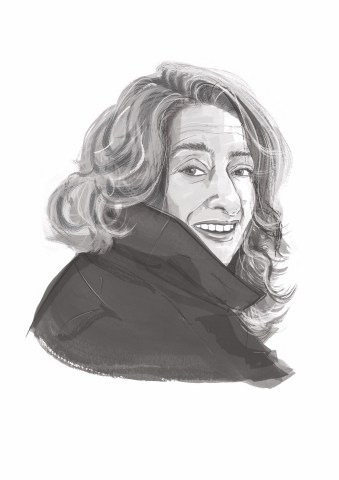Saints, scholars and queens: The women who helped forge Islam

They called her “Uwar Gari”, or the “Mother of all”.
Nana Asmau (1793-1864), the daughter of Shehu Usman dan Fodio, the founder of the Sokoto Caliphate (1806-1903) in northern Nigeria, was a patron of women and children’s rights and an exponent of education in West Africa. She taught in four languages and promoted women’s liberation through reading, writing, singing and working. Women flocked to her home and sat at her feet.
Asmau even built a team of women scholars who would travel across the caliphate and teach women in their own homes.
She was held in such high esteem, she was known in Morocco, Mauritania and western Sudan.
Stay informed with MEE's newsletters
Sign up to get the latest alerts, insights and analysis, starting with Turkey Unpacked
Asmau’s story is among those of 21 women profiled in a new book by Hossein Kamaly, A History of Islam in 21 Women, in which he details the biographies of some of the most illuminary Muslim women in Islamic history.
“She pressed the point that the mistreatment and debasement of women contradicted the exemplary conduct of Prophet Muhammad,” Kamaly, an associate professor of Islamic Studies at Hartford Seminary in Connecticut, writes of Asmau.
“To her, reviving the roots of pure Islam depended on raising the status of women.”
The book, a breezy 260-page read, is a chronologically assembled biography of five religious figures, eight rulers, four leaders within the colonial era and four others in the contemporary moment. All women.
And the stories encompass the Middle East and Central Asia, as well as India, Indonesia, Russia and the United Kingdom. Kamaly’s unusual selection might raise eyebrows, while historical scholars may frown at the simplification of complex histories into fast-paced narrations of these extraordinary women's lives, but as an introduction to some of the lesser-known exploits of Muslim women throughout Islamic history, it is instructive.
The author makes clear in his introduction that his effort is not exhaustive. The book is laced with reference upon reference to previous studies (and a seven-page bibliography) and is framed as an invitation to read Islamic history through the stories of these strong-willed, iconoclastic Muslim women.
Agents of change
There is little doubt that Muslim women were fundamental in the formative years and spread of the religion. They acted as agents of change and were very much part of the disputes and controversies that dominated the early years of the religion, as well as the attempts to reassert women’s role in the story of one the world’s great religions.
Their participation was not egregious or scandalous, as contemporary depictions seem to convey. They were businesswomen, legal scholars, teachers from the start and some of the earliest records acknowledge their role.
For instance, one of the women profiled in the book, Rabia al-Adawiyya (c. 717-801), a mystic and poet understood to have lived in present-day Iraq, remains a towering figure in Sufism. Even though much about her remains unknown and is based on legend and myth, she is a symbol of asceticism and a rejection of worldly desires.
"Rabia's example demonstrates that a woman could be a friend of God too, without even being part of the Prophet's household," Kamaly writes. "Revering Rabia emphasizes this possibility, and that being a woman does not rule out the possibility of reaching the highest spiritual rank."
Kamaly adds that the most detailed portrait of her appears in a book written by Attar of Nishapur in the 13th century.
“O Lord, should I worship you for fear of punishment, then burn me in hellfire. Should I worship you for reward, then keep me out of paradise. But I worship you only for you. So, do not withhold from me your Eternal Beauty,” is a prayer attributed to al-Adawiyya. Centuries later, in northern Nigeria, Nana Asmau would venerate her, too.
When it comes to Asmau, Beverly B Mack and Jean Boyd in their book, One Woman's Jihad: Nana Asma’u, Scholar and Scribe (Bloomington), say that though Asmau was an exceptional personality for her time, there were many other Sufi women at the edge of the Sahara who played important roles in their societies.
In her book, Women’s Rebellion and Islamic Memory, Fatima Mernissi tries to account for the contradiction between a history of scholarship that did include women and the “lowly image attributed to Muslim women in their own society today”.
Mernissi says the memory of women “as active, full participants in the making of culture” exists.
Mernissi argues that these histories have been mediated by conservative (men) who have played the role of gatekeepers to the existing annals of knowledge
Instead, she argues that these histories have been mediated by conservative (men) who have played the role of gatekeepers to the existing annals of knowledge. The advent of more Muslim women as writers and historians has meant a reclamation of this narrative.
For instance, volume eight of the work of Ibn Sa’ad, one of the Prophet Muhammad’s earliest biographers, known as Al-Tabaqat al-Kubra, which focuses on the life of the Prophet Muhammad, is dedicated completely to women in the Prophet's household. The compilation was written in the 9th century.
Still, there are more accounts of emirs, sultans and imams than there are of women, and there are even fewer accounts of less famous women.
The importance of detailing the role of women in lslamic history is imperative especially in places where “religious history” is deemed instructive, in societies where religion and state are still undivided.
‘Khadija - the first believer’
In using primary sources, as well as alluding to the stories collected and told through oral history and legend, Kamaly reveals several strands of narratives within the history of Islam itself.
“The women highlighted, who include religious exemplars, and political authorities, are too diverse to represent a single ideal or ideal type, and they seldom appear together in general histories of Islam,” Kamaly writes.
Not only was Khadija around 15 years older than the Prophet when they married, she was a successful and wealthy trader at the time
It begins with Khadija (c. 560-619), the first believer in Islam and the Prophet Muhammad’s beloved first wife. Her role is deeply seminal.
“Today, more than ever, it is important to highlight that the first person to receive the Prophet’s message was a woman,” Kamaly writes.
Not only was Khadija around 15 years older than the Prophet when they married, she was a successful and wealthy trader at the time. Drawn to his honesty and character, she asked him for his hand in marriage.
It was Khadija who received the shivering Prophet and comforted him with a blanket following his first encounter with revelation.
“Her reaction to his vocation as a divine messenger reveals the depths of her attachment to him and her confidence in his truthfulness,” Kamaly adds.
When the Prophet is then persecuted by his own tribe, Kamaly describes Khadija as “having used her standing to back her husband when he was at his most vulnerable... Khadija is a heroine of towering stature in Islamic history”.
Kamaly moves from Khadija to the Prophet’s daughter Fatima (c. 612-633) and then to his second wife Aisha (c. 615-678), who also played defining roles in the early establishment of the religion, especially after the Prophet’s death and the dispute over his successor. Fatima was especially close to her father following the death of Khadija, and cared for him so deeply that she became known as "the mother of her father".
At the time of the Prophet's passing, Fatima was married to his younger cousin and one of his earliest supporters Ali, whose followers (who became known as Shia) believe was the rightful heir to the Prophet. Instead, Aisha's father Abu Bakr, a close companion to the Prophet, became the first Caliph in Islam.
Given her "elevated position in the eyes of the community around the Prophet [...] many members of the Muslim community accepted [Aisha's] testimony that the Prophet had wished her father to lead the community as his successor," Kamaly writes.
"Sunni chroniclers highlight how she prevented the spread of confusion. By contrast, Shia chroniclers stress that she stood against the Prophet's daughter Fatima, his son-in-law Ali, and a chosen group of companions," he adds. Later, Aisha rode out to battle Ali, the-then fourth caliph of Islam, which only served to deepen the chasm.
Aisha went on to play an important role in the ordering of verses in the Quran as well as contributing more than 2,000 hadith, indicating "her acknowledged position as of one of the most prolific sources of eyewitness reports about the Prophet."
Aisha personifies the early depiction of gender equality in Islam. But her boldness is also used as an example by conservatives of all persuasions as a reason to keep women out of politics and the public sphere.
Distinct voices
Though it is clear that Islam elevated women at the time, Kamaly does not whitewash the continued misogyny of early Meccan culture.
He steers clear of romanticising the place of women in Islamic societies and resists fetishising Muslim women as fundamentally “good” or “fierce warriors”, and always in charge of their lives. Instead, Kamaly narrates the tensions and struggles for power and influence of a select number of women, who, by all measures, were extraordinary personalities.
“Islam has a long and complex history, and in this book I have tried to acknowledge and restore the distinct voice of women in it,” Kamaly writes.
For those with a vague reading of Islamic history, the book - made up of dedicated chapters for each woman - really takes off with the introduction of Rabia al-Adawiyya (ca. 717-801), the Muslim saint and Sufi mystic of Basra, Iraq, and Fatima of Nishapur (c. 1000-1088), in what is now present-day Iran.
Nishapur, originally conquered by Caliph Omar in the 7th century, became an important node in Islamic history when it emerged in the 9th century as a centre for the transmission of Hadith, the ethical worldview of the Prophet.
The two global institutions of madrassas and Sufi lodges or khanqahs also owe their development to Nishapur, while the first major steps towards agreeing on a shared methodology of the Hadith, which later became the six major Hadith collections, have their roots in Nishapur, too. Fatima worked on two of these collections and taught the Hadith, too.
Queens of the Muslim world
Kamaly describes Fatima as an integral figure in the intellectual culture of the city where women were welcomed to participate in the religious life of the community.
“Fatima’s life reflects the culture of 11th-century Nishapur, where the elite exalted religious learning and piety among women as well as men,” Kamaly writes. “This culture welcomed women’s religious participation as an element in the broader process of standardising Sunni Islam.”
Kamaly notes that while this “Sunni Revival” was in full swing in Nishapur and in Iraq under the Abbasid caliphate (750 to 1258), another woman, Queen Arwa of Yemen (c. 1050-1138), was one of the rulers who helped keep the Shia credo alive under the Fatimid Caliphate (909-1171), which traced its lineage to Fatima, the Prophet Muhammad's daughter, given her marriage to Ali.
From her base in south Yemen, Queen Arwa ruled trade routes within the country as well as across the Gulf of Aden into East Africa. In Cairo, where the Fatimid Caliphate was based, the gold coins read:
“Ali is the Prophet’s Nominee, the Most Excellent Representative, the Husband of the Radiant Chaste One.”
The centrality of women in the Fatimid Caliphate meant that Queen Arwa did not rule incidentally; she outlived two husbands and ruled her territory for 50 years.
“Queen Arwa’s daily life was typical of a Muslim sovereign of the time: she held court, minted coins; fought wars; negotiated peace treaties and other revenues; built cities, mosques; and extended patronage to builders, poets, and other exponents of high culture.”
Kamaly also profiles Nur Jahan (1577-1645), an infant abandoned on the roadside outside Kandahar (in present-day Afghanistan), who rises to become a Queen in the Mughal empire. "Her advance was groundbreaking. Within years, she wielded more power than any other woman in India, and maybe the world at the time," Kamaly writes. "She was unbreakable."
He also features Safiye Sultan (1550-1619), a Christian concubine from eastern Europe, who became the mother of the Ottoman ruler Sultan Mehmed III and later the grandmother of Sultans Ahmed I and Mustafa I.
In one of the first moves she made as the mother of an Ottoman sultan, Safiye “suspended the drowning in the Bosphorous as a punishment for adulterous women”. Safiye was known as a skilled diplomat, exchanging letters with Queen Elizabeth 1 as early as 1593.
Her first letter to Elizabeth, Kamaly notes, written “in twenty four lines on a single sheet of paper sprinkled with gold dust... opens with 'He is the Helper,' in English on the top right hand of the page.”
The spectacular Yeni Camii mosque in Istanbul, though completed decades later, began work under her tutelage. Her power and independence irritated her son. When her grandson tried to dislodge her from her perks, she had him strangled.
And perhaps this is the best aspect of Kamaly’s effort. He resists the urge to moralise or palliate the women in his collection. He narrates their history, warts and all. And though they resist male domination, they are not all vanguards of social change; many rulers are often supporters of the status quo. They are extraordinary, but they are also very human.
The difficulty with all such books is the question of omission. Kamaly could have included Hafsa, the daughter of Caliph Omar, who was entrusted with the Quran following his death in 644. Or he could have included Fatima, or Lubna of Cordoba, who looked after the Royal Library of Cordoba in the 10th Century.
Likewise, he might have reconsidered the inclusion of Noor Inayat Khan (1914-1944), a Muslim woman who becomes a spy for the British during the Second World War. Though Khan’s personal story is remarkable, that she registered for work under a Christian name does seem incongruous with the rest of the book, even if it also hints at historical struggles of Muslim inclusion in western society, even when serving empire.
Despite this, Kamaly’s book has a special resonance at a time in which Muslim women are often caricatured as powerless and dependent, and their alleged oppression is often used by western powers as justification for intervention in the Middle East. It is also part of resurrecting a history that has been repeatedly bludgeoned, exploited and buried.
A History of Islam in 21 Women, by Hossein Kamaly, is available from Oneworld Publications
This article is available in French on Middle East Eye French edition.
Middle East Eye delivers independent and unrivalled coverage and analysis of the Middle East, North Africa and beyond. To learn more about republishing this content and the associated fees, please fill out this form. More about MEE can be found here.









